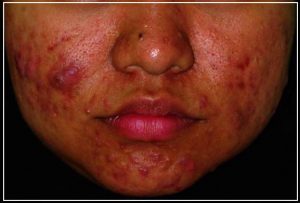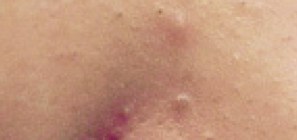There is no single best mode for management of all acne lesions . Control of different forms is determined by many factors, including types of lesions present, duration of disease, past and present response to modalities, tendency for scarring and development of spots. Knowing the symptoms and early intervention are the key to a successful management. Cystic acne may be hormonally mediated from within and without the skin, which involves in dynamic generation of androgens and imparts a conceding aspect to cystic acne treatment.

Severe acne presented with cysts and nodules, scarring is evident
Cysts and nodules especially when multiple are indicative of severe form of acne and warrant combination therapy with topical and oral agents including topical retinoids and oral antibiotics. Benzoyl peroxide may be used with this regimen, however, its use with topical retinoids is generally too drying and irritating to the skin. This is where acne skin care is substantiated and its practice in maintenance treatment of acne vulgaris, prominently a chronic disease, grow significant. Harsh skin care has been recognized as one of the aggravating factors in acne disease. Oral isotretinoin may be used in recalcitrant cystic acne not responding to other modalities in selected patients. This agent should not be resourced as a first line agent in moderate to severe acne not responding to first round of treatment and caution is exercised for its grave side effect profile.

Comedonal acne, initial stage of acne vulgaris
It is important to note that severe form as in cystic form may warrant combination therapy and must be consulted with a physician. Best approach for mild forms such as comedones (whiteheads and blackheads), small pustules and scattered papules are various treatment modalities with desquamating agents such as benzoyl peroxide. Among leading over-the-counter treatments benzoyl peroxide could be counted. Its antibacterial efficacy is noteworthy in rapid destruction of Porpionibacterium acnes. This suppressive effect is much faster compare with that of antibiotics. In contrast to antibiotics, resident organisms do not become resistant to this agent. This agent also demonstrates anti-inflammatory effect due to a reduction of oxygen free radicals. Its comedolytic effect is comparatively slight in contrast to other topical agents used to treat acne. Contact allergy is quite rare with it.
A comedolytic over-the-counter such as salicylic acid (a beta hydroxy acid), which could be used as alternative or adjunct to benzoyl peroxide in cystic acne treatment. This combination therapy for acne maybe among modalities for moderate forms and may be equally used as most effective cystic acne treatment between the flares. Salicylic acid comedolytic activity justifies its therapeutic value. Keratolytic activity of this BHA causes peeling and removal of top layer of the skin. This can result in preventing the follicles from getting plugged.
Salicylic acid is also moderately effective in destructing Porpionibacterium and shows moderate antibacterial efficacy. Combination therapy of salicylic acid with benzoyl peorxide have been postulated by a more recent study as effective in cystic acne treatment. Application of AHA’s (alpha hydroxy acids) such as glycolic acid may resolve the comedones and prevent more severe form. Use of alpha hydroxy acids alone is not indicated. However, a positive effect through control of sebum production and ductal hypercornification is likely.
Tretinoin in its oral form, isotretinoin is used in refractory cases for cystic acne treatment. Its adverse effects, most commonly skin xerosis and cheilitis mostly induced through apoptosis, should be discussed and may not be sought as an initial rescue.Topical forms is used for managing acne in its mild to moderate forms as well as as adjunct with oral treatments in severe forms of acne. Maintenance therapy between flares of acne and at home regimens is another aspect of a comprehensive treatment to prevent relapses of cystic acne. Treatment of acne vulgaris during pregnancy warrants certain considerations and more specific treatment protocol.
Guidelines of care aids us to treat according to more conventional methods yet more evidence based medicine suggest alternative approaches with a focus more reverent to the skin native microbiome and lipids. Preservation of skin’s own microbiome and avoidance of aggressive use of antibiotics gain more traction in recent literature and call for review of acne treatment guidelines. Natural lipids with antibacterial properties which have been avoided for more than two decades in the guidelines are now focus of attention of multitude of studies on cystic acne treatment. Herbs and naturally-derived preparations may become more studied and recognized in future acne armamentarium. Lately, diet has gained far greater acknowledgement and relevant dietary precautions have been introduced in management of acne vulgaris as it is a chronic ailment and its maintenance as in at home cystic acne treatment in the form of diet, skin care, topical treatments is substantiated.